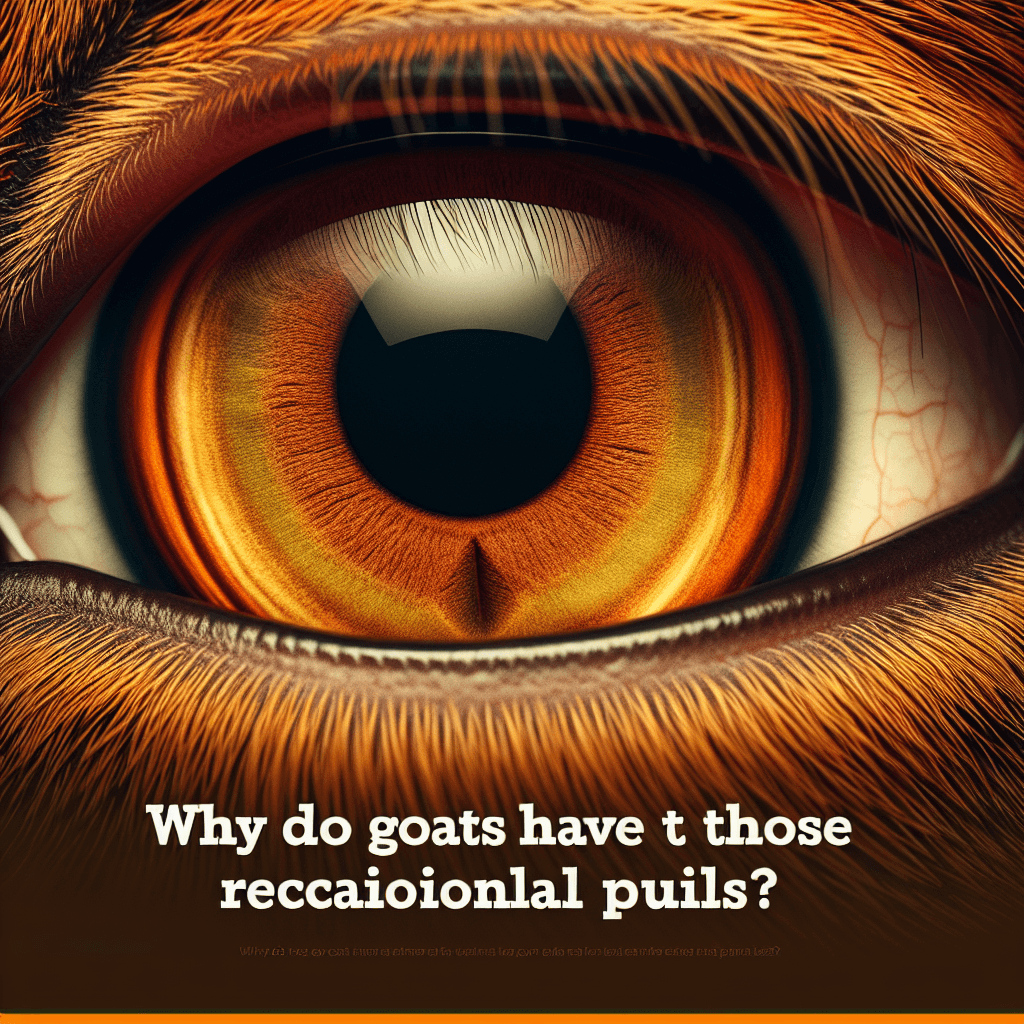The Eyes Have It: Why Do Goats Have Those Weird Rectangular Pupils
Ever felt unsettled looking into a goat's eyes? Their peculiar, horizontal rectangular pupils aren't a random quirk of nature; they're a sophisticated evolutionary advantage.


Too Long; Didn't Read
Goats have horizontal, rectangular pupils to provide a wide, panoramic field of vision for spotting predators, while simultaneously shielding their eyes from the glare of the sun.
The Eyes Have It: Why Do Goats Have Those Weird Rectangular Pupils?
Ever locked eyes with a goat and felt a little… unsettled? Beyond their often-comical antics and impressive climbing skills, one of the most striking features of a goat is its eyes. Specifically, those peculiar, horizontal, rectangular pupils. They look almost alien compared to our own round pupils or a cat's vertical slits. But this isn't just a random quirk of nature. These "weird" pupils are a sophisticated evolutionary adaptation. This blog post will delve into the fascinating science behind why goats have rectangular pupils, exploring how this unique trait helps them survive and thrive.
The Shape of Survival: Understanding Pupil Function
Before we focus on goats, let's quickly recap what pupils do. The pupil is essentially an opening in the center of the iris (the colored part of the eye) that allows light to enter and reach the retina. The size of the pupil changes to control the amount of light entering – constricting in bright light and dilating in dim light. The shape of this opening, however, significantly influences how an animal sees the world.
While humans and many active predators have round pupils, other animals sport different designs. Goats, along with many other grazing animals like sheep and horses, possess distinctly horizontal rectangular pupils.
A Panoramic View: The Ultimate Predator Detection System
The primary reason for these rectangular pupils lies in a goat's place in the food chain: they are prey animals.
- Expansive Vistas: Horizontal pupils provide an incredibly wide, panoramic field of vision. Goats can see approximately 320 to 340 degrees around themselves without moving their heads. Compare this to humans, who have a field of vision of about 180 degrees. This "visual sweep" allows them to scan the horizon for approaching danger from almost any direction.
- Minimizing Blind Spots: This wide view significantly reduces blind spots, making it much harder for a predator to sneak up on them.
- Clear Horizon, Blurred Sky: These pupils also help create a sharper image of the horizontal plane (the ground where predators approach) while blurring less important vertical details, like the bright sky above, which could otherwise be dazzling.
According to a 2015 study published in Science Advances by vision scientist Martin Banks and his team, this shape helps prey animals see a panoramic view of their surroundings, which is crucial for detecting predators.
Enhancing Light Control and Night Vision
The rectangular shape isn't just about the width of vision; it's also about light management.
- Effective Dilation: When dilating in low light, these pupils become larger and more rectangular, still maximizing light intake from the horizon where danger lurks.
- Precise Constriction: In bright daylight, the pupils can constrict to a very narrow horizontal slit. This drastically reduces the amount of incoming light, protecting the sensitive retina from sun glare, especially light coming from above. This is crucial for an animal that spends most of its day outdoors.
This ability to sharply reduce incoming light while maintaining a wide horizontal view is a distinct advantage for animals that need to be constantly vigilant.
The Amazing Eye Rotation: Keeping it Level
Perhaps one of the most astonishing aspects related to a goat's rectangular pupils is their ability to rotate their eyes. When a goat lowers its head to graze, its eyes can rotate up to 50 degrees. This remarkable feat, known as cyclovergence, ensures that the pupils remain parallel to the ground, regardless of head position. Why is this important?
- Consistent Panoramic Scan: It maintains that crucial panoramic view of the horizon, even while their head is down, munching on grass.
- Stable Vision: It keeps their visual field stable, allowing them to instantly spot any approaching threat without having to lift their head first.
This adaptation means a grazing goat is never truly "off-guard."
A Common Trait Among Grazers
Goats aren't alone in this ocular adaptation. Many other ungulates (hoofed animals) that are primarily prey species, such as sheep, deer, and horses, also have horizontal pupils. This shared trait underscores its evolutionary significance for animals vulnerable to predation. In contrast, ambush predators like cats and snakes often have vertical slit pupils, which help them judge distances accurately when pouncing.
The specific shape and orientation of an animal's pupils offer a fascinating glimpse into its ecological niche and the survival strategies it has evolved.
In conclusion, a goat's "weird" rectangular pupils are far from a random design flaw. They are a finely tuned evolutionary masterpiece, providing these animals with a distinct survival advantage. From offering a sweeping panoramic view to detect predators, to expertly managing light and maintaining a level gaze while grazing, these unique eyes are a testament to the incredible ways life adapts to its environment. So, the next time you see a goat, take a moment to appreciate the sophisticated visual system looking back at you – it's a window into a world shaped by the constant dance between predator and prey.
More Articles

Why do movie punches sound so much crunchier and louder than real ones?
That sickening, bone-crunching punch you hear in the movies is a lie, and the secret ingredient is probably sitting in your refrigerator right now.

What makes a beer bottle suddenly foam over just from a light tap on top?
It’s not magic, it’s a shockwave; discover the explosive physics that turns a gentle tap on your beer bottle into an instant foamy geyser.

Why do police officers touch the back of a car during a traffic stop?
It’s not a random habit; that simple touch is a calculated, old-school tactic designed to leave a crucial and potentially life-saving piece of evidence behind.